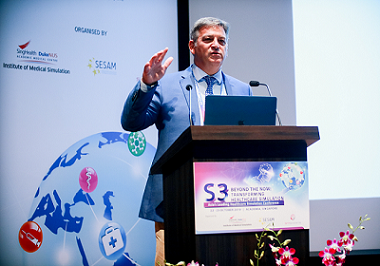ImmersiFit
Introduction:
Adolescent obesity has become a critical public health challenge, frequently accompanied by comorbidities such as asthma, insulin resistance, and orthopaedic complications (Oliveira et al., 2023). Traditional clinical exercise programmes demonstrate poor long-term adherence rates, primarily due to low motivation and negative affect among adolescents (Kelly et al., 2022). In Singapore, the challenge is particularly acute, with patient retention in clinical exercise programs being notably low due to conflicts with academic commitments (Tham et al., 2023). Studies indicate that conventional programmes fail to engage participants due to their repetitive nature and lack of clear progression markers (Liu et al., 2022).
Description:
The initiative employs spatial computing and mixed reality (MR) platforms, specifically the Apple Vision Pro, implementing several key components (Egger et al., 2020; Tinga et al., 2022):• Interactive training regimes with virtual character guidance
• Personalised feedback systems incorporating Self-Determination Theory elements (Ryan & Deci, 2017)
• Adaptive exercise protocols that adjust based on individual performance
• Clinical management through companion applications
• Integration of physiological monitoring via Bluetooth sensors
• Standardised protocols for equipment handling and environment setupThe evaluation framework includes multiple metrics:• Adherence tracking (attendance rates, session duration)
• Physiological measurements (peak oxygen uptake - VO2peak, anaerobic threshold)
• Body composition analysis
• Qualitative assessment through user experience surveys (Staiano et al., 2017)
Discussion:
The integration of spatial computing with clinical exercise represents a significant advancement in adolescent obesity treatment. Studies demonstrate that MR systems can consistently achieve moderate-to-vigorous exercise intensities necessary for improving aerobic fitness (Egger et al., 2020). Pilot trials have shown high usability rates and minimal cybersickness in youth populations (Tinga et al., 2022).However, several challenges persist:• Economic barriers related to device costs and availability
• Requirements for specialised clinician training
• Potential decline in engagement due to novelty wear-off
• Need for continuous content updates
• Limited large-scale clinical validation (Waddington et al., 2022)Future research directions should explore:• Hybrid intervention models combining MR and traditional training
• Cost-effectiveness analysis across different clinical settings
• Methods for maintaining long-term engagement
• Solutions for hardware limitations during certain exercises (Plante et al., 2003)
The convergence of these technologies with clinical practice represents a promising approach to addressing the complex challenges of adolescent obesity treatment (Hoffmann et al., 2022).
© 2025 SingHealth Group. All Rights Reserved.














